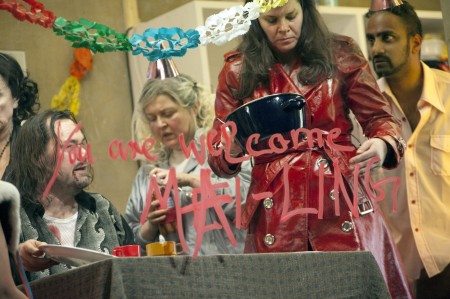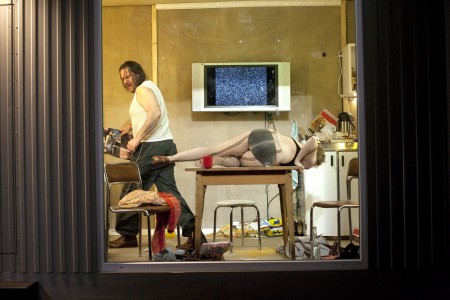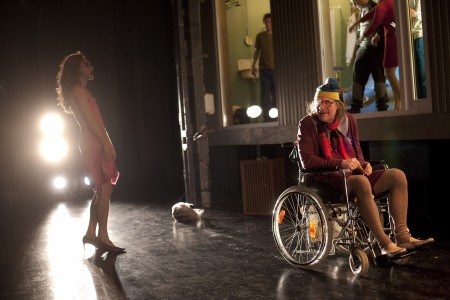Say what you will about „Die Schmutzigen, die Hässlichen und die Gemeinen“ („Ugly, dirty, bad“), but don’t accuse Karin Beier of being naive. In her 2010 theater version of Ettore Scola’s 1976 neo-realist film about a shanty town family, Beier is fully aware that neo-realist methods are risky, if not suspect, in this day and age. In portraying the violence, adversity and sexual perversions of a very poor family, Beier seems to suggest that it is no longer possible to simply bare these terrors in an art context, that it is passé to merely represent them, to put „real life“ (whatever that may mean) on stage.
With a hyper-awareness of such representational problems, Beier aestheticizes the neo-realist source material, making it, in a way, a museum piece. Using a soundproof glass wall stage design (Thomas Dreissigacker) that suggests a shadow box or a vitrine in a museum, Beier separates us from the horrors of being portrayed on stage by another soundproof fourth wall. As a consequence, the viewer watches this mediated violence but hears next to nothing (except in the moments when the actors leave the container); something which, clearly, creates another level of distance.

Life Inside a Glass House. Photo: David Baltzer
This aesthetic tactic draws our attention to our voyeurism, our desire to watch depravity before we drink a glass of champagne at the premiere party and then take a taxi home. We, following this line of thought, become aware that we may be watching horrors on stage (and we might even write about them on our MacBook Pros, like yours truly) but in the end the worries we see on stage are (most likely) not the worries of our own lives. Unfortunately, such po-mo gestures are like drinking cold coffee that’s been reheated in the microwave (if I’m reading a book, I don’t need to be reminded all the time that I’m reading a book, thank you, and if I’m sitting in the theater, then I’m quite aware that I’m only watching a representation of violence, thank you): sure, reheated coffee gives you a kick but ultimately it doesn’t taste as good as a freshly brewed cup.
This isn’t to say that I’m suggesting we just put violence on stage (see comments above about neo-realism), but that it seems necessary for us today to find our own means of dealing with violence in art and that just framing it doesn’t seem to be enough.
This problem, I’m aware, is not a new problem but it seems to be one which requires new answers all the time.
But let’s get back to the performance.

Welcome Home! Photo: David Baltzer
In the beginning, „Die Schmutzigen, die Hässlichen und die Gemeinen“ served as a very satisfying theater experience. There was a beautiful sense of choreography and movement across the stage, and every time one of the actors left the container, it was always a real shock to hear their voices. These moments served as points of friction much more than the super aestheticized representations of violence. Indeed, every time the phrase „where are you going?“ was heard when one of the characters left the stage, I felt like this simple German word „wohin?“ had some real power behind it, like it meant a lot in a world that’s torn apart by so many problems.
The performance continued to show its strengths throughout the first half when all of the characters wanted something from the father, played by Markus John. We watch how all of the other characters beg for money from him and when he can no longer stand all the desperation, he steps out of the container and stares out into nothingness (i.e. the audience) and gets drunk. As his silence stretched out longer and longer, its immediacy became more and more felt: not only does his family in the drama want something but never get anything, but we too get nothing from him. A powerful reminder of the voyeurism aspect.
Unfortunately, the actors began leaving the container more and more, playing and speaking outside of the container, including a super camp dance scene a la 1980s Almodovar. And while this new use of the stage felt exciting at first, the more it happened, the more it changed the dynamics of the piece (and, in part, some of the aesthetic goals; i.e. it seemed to disintegrate some of the other questions it had been asking and started asking others, like: what’s the relationship between what we see behind the glass wall and the violence we see on top of the container? Are we supposed to make another leap into the violence we see in real life?).
It was somewhere around the camp dance scene that I began to lose interest in the production as a production: it seemed too easy and trite to have a cross dressing man dance on stage and blow smoke at the audience. I wondered, would it have been more effective in glass? And in a way, I think yes, it would have been more effective, because then it would have been within the world that Beier created and not just pure entertainment for the audience. This scene and accompanying decision seemed like a fatal break for me. It was a moment when I was inextricably drawn out of the production, a moment where I found it difficult to enter back into the material, the production and its aesthetics.

The Moment Where Everything Broke (for me). Photo: David Baltzer
Although I had some problems with the production on the micro level, on a macro level it fascinated me.
I found myself asking myself a number of questions, none of which I really have an answer to, but they feel urgent and important. Perhaps you, the reader, have some ideas (or even other questions) to add to these questions. Here are a couple of them:
1. What would be an appropriate representation of violence in art today?
2. Should it be represented at all? On stage?
3. Does aestheticizing violence create an interesting viewer experience? Or does it fetishize it?
4. What’s the purpose of representing the lower classes for the upper classes? Don`t reality TV / day time talk shows do this better?
5. What if Beier had aestheticized it further? What if, instead of just putting clichés about the lower classes behind glass, she had painted everything white, what if she had made everyday objects nearly unrecognizable?
6. How far can such aestheticized distance be pushed?
Art, in my opinion, is not there to provide answers to the world’s problems in an hour and a half (how wonderful/boring life would be if this were true!).
Art is valuable in that it frames questions, in that it draws attention to the problems that we usually willfully ignore.
Art is interesting in that it challenges our beliefs and doesn’t just reaffirm them.
All in all, „Die Schmutzigen, die Hässlichen und die Gemeinen“ was a good production that made this blogger think about the BIG QUESTIONS.